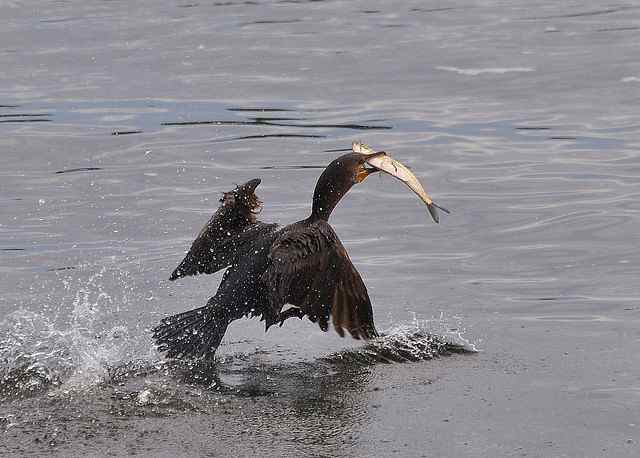forum
library
tutorial
contact

Salmon in Columbia River
Endangered by Seabirds
by Alex Lemieux
Liberty Voice, February 9, 2015
|
the film forum library tutorial contact |

|
Salmon in Columbia River
by Alex Lemieux
|
... enlisted the help of many experts of aquatic birds and fish to reach an option with the least poorest outcome.
 Salmon that inhabit the Columbia River in Washington State are being threatened with endangerment by the increasing numbers of seabirds that inhabit the area. In order to address the dwindling numbers of salmon, federal officials now plan to eliminate 11,000 double-crested cormorants. These aquatic birds, according to scientists, have been feeding on a large amount of trout and native salmon, which has allowed numbers of both species to drop to very low levels in the Columbia River.
Salmon that inhabit the Columbia River in Washington State are being threatened with endangerment by the increasing numbers of seabirds that inhabit the area. In order to address the dwindling numbers of salmon, federal officials now plan to eliminate 11,000 double-crested cormorants. These aquatic birds, according to scientists, have been feeding on a large amount of trout and native salmon, which has allowed numbers of both species to drop to very low levels in the Columbia River.
The plan derived is to fire upon the thousands of aquatic birds in question. This plan was created by the U.S. Army Corps of Engineers and was included in a portion of the final format of the Environmental Impact Statement which is currently in the review process. If this plan goes forth, state agricultural staff will shoot the cormorants and douse their eggs with a chemical that would not allow the eggs to hatch, thus containing the endangerment problem.
A representative from the U.S. Army Corps, Diana Fredlund, explained that this procedure is more encouraging over the second option which would allow for the destruction of 18,000 predatory birds to be concluded by 2018. She said that coming to this conclusion was very difficult, and that this is a challenging situation. Since officials are attempting to find the balance between the native fish and the aquatic bird populations, the analysis of the situation takes time. Fredlund stated that they enlisted the help of many experts of aquatic birds and fish to reach an option with the least poorest outcome.
Other alternative plans have been considered. One plan was to rid the birds from the area with smog and smoke, allowing a man-made implementation of pollution to drive them from the area. However, they believed that the birds would only change areas and would continue to feed off of trout and salmon and put the river's underwater species at further risk.
The NOAA's analysis, published in the Biological Opinion, focused mainly on the reduction of the bird population of the Columbia River from its current 13,000 breeding pairs to less than 6,000 over a period of four years. Experts stated that these aquatic birds have a tendency of feeding on young salmon and trout due to their lack of swimming and defense ability compared to adult fish. If young fish keep dying out, the numbers will continue to decrease every year, and less breeding pairs of offspring will be born. Because of this, a large number of young salmon and steelhead trout have been added to the list of Endangered Species as being either endangered or further threatened with endangerment.
Those from the Portland, Oregon Audubon Society stated that the main reason the population of Columbia River salmon is being threatened is not because of predatory aquatic birds. They explained that the blame should be focused on fish hatcheries, dams and further habitat loss due to the encroachment of human involvement on the region.
Bob Sallinger, the conservation director of the Audubon Society, stated that he feels the birds have taken the brunt of the blame. He believes that even though the aforementioned threats to the fish population have been proven to be a factor in fish loss, the major reason behind the endangerment has not been acknowledged. He explained that the bird population may be acting as a scapegoat for further development of dams, fish hatcheries and other region-affecting planning and implementation.
Sallinger stated the Audubon Society plans to fight what the U.S. Army Corps has decided to do to eliminate birds around the Columbia River. They also plan to take the Corps to court to put a stop to the decision. Whether or not seabirds, dams or fish hatcheries are the main source of the reduction of trout and salmon in the Columbia River, all agree that they are being threatened with endangerment, regardless of the reason.
Related Pages:
Watch Bill Supports Killing Sea Lions at Bonneville Dam by Chris Holmstrom, KOIN 6 News, 1/29/15
learn more on topics covered in the film
see the video
read the script
learn the songs
discussion forum
